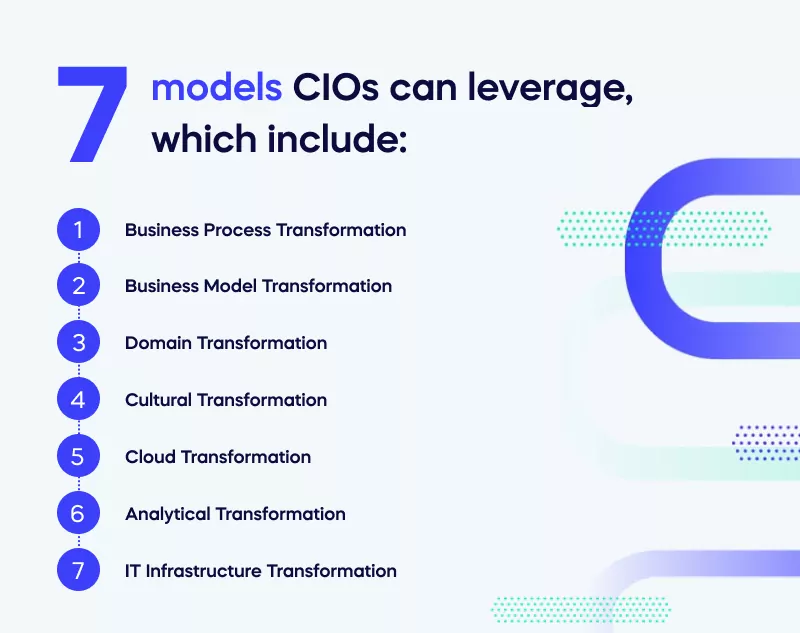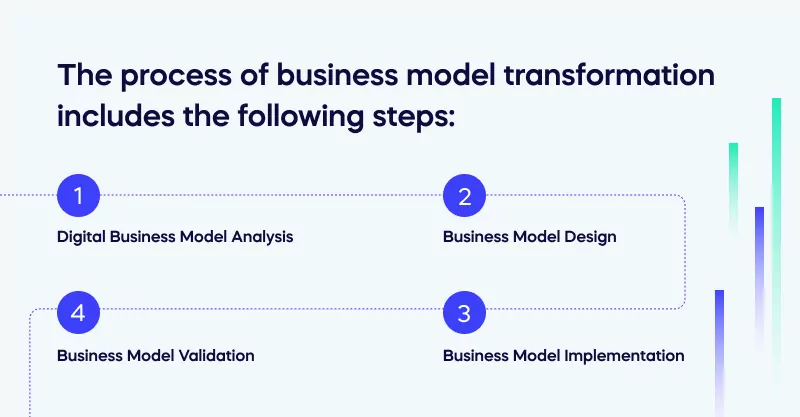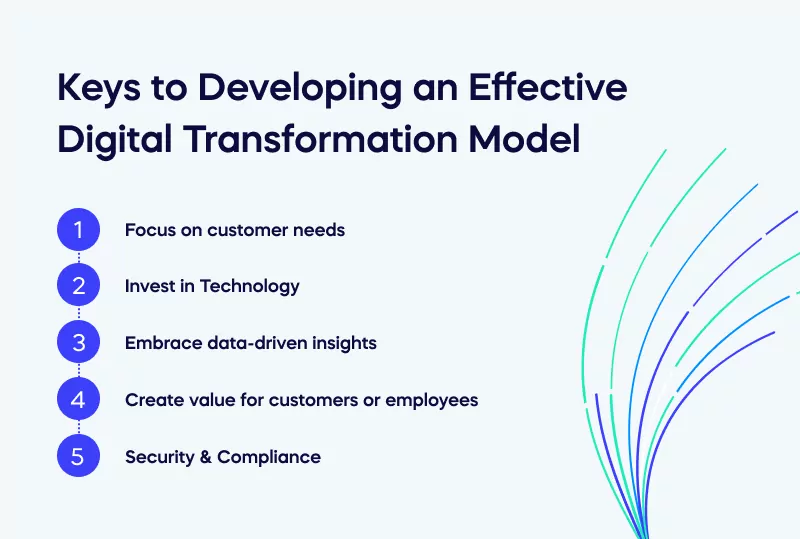Leveraging innovative digital technologies to evolve contemporary business processes, culture, and customer experience (CX) sits at the core of digital transformation (DX).
With the macroeconomic uncertainty caused by the COVID-19 pandemic and the more recent geopolitical tensions between Russia and Ukraine, global business models are undergoing a rapid sea of change- and digital technology is emerging as the catalyst for affecting such change.
In addition, modernizing static legacy systems, reducing operating expenditure, increasing ROI, and maintaining customer centricity in an increasingly online world also necessitates today’s delivery of innovative digital-driven solutions.
Statistics from Research & Markets show the international digital transformation market is estimated to experience immense growth by 2025. From a value of 594.5 Billion in 2022, it’s anticipated to rise to 1,548.9 Billion USD by 2027 – boasting an impressive CAGR of 21.1% during this period.
In this article, we’ll explain what a DX model is, discuss the advantages and disadvantages of each DX model, and help CIOs and digital leaders identify strategic priorities for developing effective models and driving business velocity.
The DX models outlined in this article should serve as a comparison framework helping CIOs, and digital leaders determine which models best enhance an organization’s unique specifications and objectives. We’ve compiled seven models CIOs can leverage, which include:
-
Business Process Transformation
-
Business Model Transformation
-
Domain Transformation
-
Cultural Transformation
-
Cloud Transformation
-
Analytical Transformation
-
IT Infrastructure Transformation
Harnessing digital transformation to bolster progress is now a foundational requirement for businesses that want to survive. Seizing this opportunity can be the difference between unbridled success and impending failure. CIOs that embrace the opportunity to use digital transformation to enhance customer service and optimize their operations will have a competitive advantage over those that don’t.
What is a digital transformation model?
A digital transformation model is a strategy that organizations use to integrate new technologies and processes into their operations. It involves establishing key objectives, such as improved customer satisfaction and cost optimization.
To ensure success, CIOs must identify the most suitable digital transformation model for their organizations and set the proper criteria accordingly. This includes evaluating potential models based on scalability, expense reduction, user experience, ease of implementation, and sustainability.
The chosen model should incorporate technology that can be quickly integrated into existing systems and processes with minimal disruption while providing long-term benefits in terms of increased operational efficacy and consumer delight. By selecting the ideal model, CIOs can ensure that their organizations achieve optimal success in their digital transformation journey.
Identifying the strategic priorities for digital transformation
As organizations realign their business models, strategies,
and processes, honing in on strategic priorities and enacting a path to achieving their goals has been the preferred modus operandi of those tackling the economic disruptions of recent years. With the organizations finally graduating with a steep learning curve, they’ve begun reassessing their investments and fine-tuning their DX efforts, leading to more significant business outcomes.
“There’s no doubt that organizations have improved their digital transformation strategies and efforts over the past year. They’ve made some really great strides,” says Charlene
Li, chief research officer at management consulting firm PA Consulting. “Now companies are starting to think about their business in a completely different way—the partners they need, the types of customers they have, and what new businesses they want to get into,” Li says.
With that in mind, the need for restructuring strategic priorities may include optimizing product management processes, utilizing the Internet of Things (IoT) and AI to deliver better digital services and products, supporting value creation with increased visibility through cross-partner collaboration, or adopting technologies to streamline business processes and deliver more business value.
In Harvard Business Review’s 2022 Analytic Services survey exploring the primary business goals of an organization’s digital transformation efforts over the next 12 months (Jan – Dec 2022), 34% of respondents say it’s to enhance customer satisfaction, 33% say it’s to increase productivity and efficiency, 22% want to improve product/service quality and 33% want to better analyze enterprise data to uncover new business and operation insights.
DX strategic priorities identified by many forward-thinking companies are focused on three main objectives: creating competitive advantage, increasing customer experience, and improving operational efficiency.
Creating a competitive advantage involves leveraging digital capabilities such as analytics, automation, and AI to develop new product offerings or services while ensuring customer loyalty. Strategies like personalization, contextual marketing, and omnichannel engagement play increasingly essential roles in delivering an engaging customer experience. Alternatively, DX initiatives may improve operational efficiency by streamlining back-end operations, increasing customer-facing service capabilities, or employing predictive analytics to optimize supply chain processes.
Different digital transformation models
Digital transformation is an ongoing journey with no end goals in sight. To meet customer demands, companies must cultivate a mindset and culture of continual advancement, which may include overhauling business processes and models, embracing new technologies and solutions such as cloud computing, and integrating user feedback into regular operations to sustain improvement indefinitely.
Below we’ve outlined five digital transformation models CIOs can leverage to enhance their IT operations and meet their organization’s unique requirements.
-
Business Process Transformation
Business process transformation can be defined as a holistic approach to improving the performance of an organization by focusing on and optimizing its processes.
Digital transformation initiatives for overhauling business processes include marketing, sales, operations, customer service, finance, and accounting. Business process transformation typically focuses on simplifying processes, automating workflow, and increasing agility to meet shifting market demands.
An organization’s CIO may want to navigate business process innovation and alter internal operations by adopting this DX model, as it affects how employees access new technology and use it to fulfill their daily tasks. Or they may want to enable cost reduction, as the rise of deep learning technologies like AI-driven automation and intelligent business process optimization can significantly lead to decreased labor costs.
Implementing agile business process transformation on behalf of CIOs and digital leaders may require utilizing methodologies such as Design Thinking, Agile Methodology, or Lean Six Sigma. These methodologies work by analyzing existing business processes and then developing strategies focusing on user needs, process improvement, and optimization.
Business process transformation for CIOs is about more than just technology; it requires a clear understanding of the organization’s digital maturity, objectives, and strategic goals. This digital transformation model can help organizations achieve their digital goals faster when applied correctly.
-
Business Model Transformation
Business model transformation is the process of changing how a business operates and creates value for customers and can be characterized by a set of strategic initiatives that companies undertake to innovate and take advantage of emerging digital technologies.
CIOs may want to implement this digital transformation model as it can help them gain a competitive advantage, allowing them to identify new opportunities in the market and restructure their processes and operations to innovate. Business model transformation also encourages companies to develop new digital capabilities and adopt nascent technologies such as the integration of cloud computing, big data analytics, artificial intelligence (AI), and the Internet of Things (IoT).
Business model transformation can also involve changes to internal and external processes, such as customer-facing operations, organizational structures, or the development of innovative new products. As such, transforming business model processes requires CIOs to address a variety of changes within the organization to ensure they’re ready to embrace digital transformation.
The process of business model transformation includes the following steps:
1. Digital Business Model Analysis – To determine the current state of the business model and identify where it needs to change to capitalize on new opportunities.
2. Business Model Design – The CIO should design a new business model focusing on customer experience, value proposition, and organizational capabilities.
3. Business Model Implementation – CIOs should develop a strategy for implementing the new business model to ensure its success.
4. Business Model Validation – After the model has been launched, validate it using data from customer feedback and other sources.
By opting for business model transformation, CIOs have the potential to create new value for customers and gain a competitive advantage in their respective markets. However, business model transformation can be a daunting process that requires considerable time, money, and resources. Therefore, it’s vital for CIOs to carefully consider the benefits and risks associated with this transformation model before making a decision.
-
Domain Transformation
The constant emergence of new and innovative technology has blurred the boundaries between businesses and industries with its ability to reimagine products and services. This has resulted in unexpected competition from new entrants, meaning companies must be agile and ready for change. Digital transformation models such as domain transformation can help them make this transition smoother.
Domain transformation is the process by which a business shifts its focus, capability, and resources from one market or industry to another. A CIO may use the domain transformation model because it presents an opportunity to expand and grow their business while simultaneously diversifying their portfolio.
Domain transformation also helps companies gain new skills and knowledge by taking advantage of new tools, services, and insights from other sectors. It can also help them become more competitive in the market by leveraging the experience of other businesses that have already gone through the same process.
The domain transformation model focuses on understanding customer needs and market trends and developing the necessary processes and technology to execute a successful transition. This includes building a strategy, implementing change initiatives, and assessing the impact of the changes on the business. Additionally, the model requires developing a process for monitoring and evaluating said progress so adjustments to the transformation plan can be made quickly and efficiently.
By leveraging new technologies and strategies to create innovative products and services that cater to evolving customer demands, this transformation model can unlock the potential of existing markets and open up opportunities for companies to grow and expand.
-
Cultural Transformation/Organization Transformation
A cultural transformation is a process of change that seeks to improve an organization or community’s culture by shifting the collective values, beliefs, and behaviors.
It involves assessing the current environment, understanding what needs to be changed, and launching strategies that help create a new, vibrant culture. Cultural transformation models can aid in this process by assisting CIOs and communities to look at their current culture and make a change plan.
Reflecting on the existing culture and recognizing what needs alteration is imperative to incite a positive transformation within an organization or community. Once cultural issues are identified, the cultural transformation model can help formulate steps to achieve the desired ambiance and structure. This includes focusing on cultural elements such as organizational structures and procedures, cultural values, relationships with stakeholders, and communication channels.
Furthermore, cultural transformation models help introduce cultural change initiatives, such as employee engagement and cultural workshops. They can also guide in facilitating organizational changes, such as cultural audits and diversity training. Additionally, cultural transformation models can help organizations assess progress to ensure their cultural change initiatives achieve the desired results.
Ultimately, cultural transformation models can be an effective tool for CIOs spearheading cultural change in organizations and communities. By providing a framework for understanding the cultural landscape, cultural transformation models can enable CIOs to make informed decisions and create a positive cultural transformation.
-
Cloud Transformation
The cloud transformation model is a digital transformation strategy focusing on leveraging cloud-based technologies, such as software-as-a-service (SaaS) and infrastructure-as-a-service (IaaS), to optimize processes and operations. This model centers around relocating IT assets from on-premise to cloud platforms to improve scalability, agility, and cost savings.
The benefits of this model are numerous – it can decrease operational costs by transitioning from capital expenditure models to pay-as-you-go models for computing power and storage. It also offers improved scalability since businesses can demand vast computational power or storage.
Cloud transformation models improve security by utilizing the latest tools and technologies for data encryption or backup solutions. Moreover, the cloud provides multi-tenancy capabilities, enabling organizations to share resources amongst users while ensuring they remain isolated.
The cloud transformation model can help CIOs accelerate multiple initiatives, such as implementing automated DevOps processes for faster development cycles and improved customer service. Additionally, CIOs can utilize this model to quickly adapt to seasonal demand changes by scaling up or down quickly depending upon needs.
They can also use it to ensure quicker response times by taking advantage of high-availability services offered by public clouds like AWS or Azure. The cloud allows CIOs to leverage various Artificial Intelligence (AI) and Machine Learning (ML) services for faster problem-solving or decision-making processes within their organization.
-
Analytical Transformation
The Analytical Transformation model uses data and analytics to understand customers, processes, and operations better. This model is used to uncover opportunities for improvement in areas such as customer experience, compliance, cost reduction, and risk management. Organizations can develop more informed strategies by unlocking the massive amounts of data that companies have access to and transforming it into actionable insights.
Analytical transformation helps CIOs accelerate initiatives related to improving customer service through predictive analytics, managing risk by utilizing fraud detection algorithms, enabling contextual marketing with better personalization options, and driving product development with insights from customer behavior analysis.
The benefits associated with this model include improved decision-making capabilities; increased efficiency in core operations due to automated data processing systems; easier auditing thanks to reliable tracking protocols; and higher ROI resulting from accurate predictions of customer preferences.
Organizations looking to benefit from the analytical transformation model need a combination of the right technology tools – such as an enterprise-grade business intelligence platform or an advanced analytics suite – and talented personnel capable of distilling information from raw data sources. Once these components are in place, businesses will have the necessary infrastructure to streamline their decision-making process and create a competitive advantage in their respective industry.
-
IT Infrastructure Transformation
IT infrastructure transformation is essential for CIOs in the modern business landscape. It involves strategically transforming IT systems and processes to provide better scalability, security, and performance. This model has many benefits, including cost reduction, improved customer experience, and lower turnaround times.
IT infrastructure transformation is driven by several key initiatives, such as consolidation and virtualization, automation and orchestration, cloud adoption, and mobile enablement. By consolidating and virtualizing existing systems with modern technologies, IT teams can reduce costs associated with buying new hardware or software licenses.
Automation and orchestration can maximize the utilization of existing resources while ensuring consistent quality of service across different services. Cloud adoption further reduces overall costs since businesses must only pay for what they use.
In addition, mobile enablement can allow companies to offer their customers a more responsive service while increasing productivity from staff working on the go. All these initiatives help to create an agile IT infrastructure that allows CIOs to accelerate their time-to-market for new products or services.
Keys to Developing an Effective Digital Transformation Model
CIOs need to understand the challenges associated with creating a digital transformation model and the keys they should focus on to increase their chances of success. These include focusing on customer needs and investing in technology, embracing data-driven insights, creating value for customers or employees, and adhering to security & compliance regulations. Let’s examine these components further.
Focus on customer needs: When developing a digital transformation model, organizations should strive to identify customer needs and develop suitable solutions which satisfy those requirements.
Invest in Technology: Organizations must invest in the right technology to succeed in their digital transformation processes. The aim should be to select cost-effective yet reliable technology that meets the organization’s specific needs and requirements.
Embrace data-driven insights: To maximize success, CIOs should harness data to provide valuable information that effectively informs decisions and guides strategies. Analyzing industry trends and understanding customer behavior can also help them create better experiences for customers or employees.
Create value for customers or employees: Creating positive experiences or delivering value for customers and employees should be a top priority when developing new business models. Organizations must ensure that their initiatives are tailored to meet the relevant user segments’ expectations while providing maximum value at the same time.
Security & Compliance: Organizations need to pay special attention to their digital transformation models’ security and compliance aspects. Any breach of these regulations could lead to heavy penalties or fines from governing bodies like GDPR or HIPAA. Especially in some countries, it could jeopardize an entire project depending on its scale and magnitude.
Challenges of Adopting a Digital Transformation Model
CIOs face various challenges when choosing and launching a suitable digital transformation model. These include a need for clarity on goals and objectives, difficulty in identifying the most appropriate technology for their needs, limited budgets to invest in transformation initiatives, inadequate management support, and slow adoption of new processes by employees.
Additionally, organizations must assess their resources carefully before committing to any model to ensure they have sufficient resources and capabilities to execute it effectively. Understanding stakeholder interests and expectations can also ensure successful outcomes and smooth collaboration among various parties. By addressing these challenges head-on, CIOs can maximize their chances of achieving successful digital transformations.
How CIOs can choose the suitable transformation model
Digital transformation is crucial to the modern IT landscape, so CIOS must adopt suitable transformation models. Research from McKinsey shows that when organizations transform to improve performance, those efforts fail 70% of the time. Moreover, the transformation process must be well-thought-out, focusing on understanding customer needs and the resulting business impact.
To ensure smooth transitions and successful digital transformation, CIOs must adopt a thoughtful approach that will help inform the selection of tailored digital solutions best equipped to address the organization’s specific needs. Leveraging this information with effective executive leadership strategies will create a solid foundation for the transformation process.
Additionally, setting clear goals for the transformation process, having a well-developed plan updated to reflect changing objectives, sharing successes and failures openly, investing in new technologies such as robotic process automation, and offering a wide range of resources tailored to the organization’s specific needs can help maximize chances of success.
By recognizing the importance of adequately investing their resources into tailored digital solutions and utilizing effective executive leadership strategies, CIOs can help their organizations unlock transformative power while minimizing risks associated with failed implementation.







